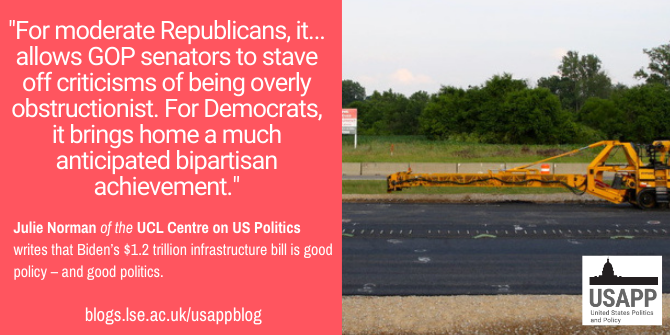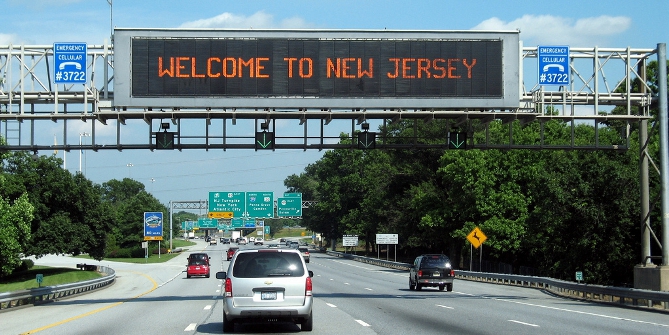 The Senate is set to pass a $1.2 trillion infrastructure bill with bipartisan support. In this Q&A, Julie Norman explains what’s in the bill, what it means for Biden, and what’s next for Democrats – who are also pushing another infrastructure bill.
The Senate is set to pass a $1.2 trillion infrastructure bill with bipartisan support. In this Q&A, Julie Norman explains what’s in the bill, what it means for Biden, and what’s next for Democrats – who are also pushing another infrastructure bill.
What’s included in the bipartisan infrastructure bill?
The $1.2 trillion bipartisan bill – which is set to be voted on by the US Senate on Tuesday following months of negotiations – includes $550 billion in new spending to invest in various areas of American infrastructure. It includes funding for traditional infrastructure such as roads, bridges, airports, ports, rail, and transit, as well as upgrading water systems, rebuilding the electric grid, upgrading broadband and internet access, and developing a network of electric vehicle chargers. It also includes $21 billion for environmental clean-up of hazardous waste sites and $1 billion to “reconnect communities,” mostly Black and low-income neighborhoods that were divided by past highway construction and infrastructure development.
How is it being paid for?
Democrats had hoped to finance the infrastructure bill by raising corporate taxes, but that plan was rejected by Republicans. The bipartisan team instead compromised on diverting unused COVID-19 relief funds to infrastructure, and increasing tax regulation of cryptocurrency transactions. Nonetheless, the nonpartisan Congressional Budget Office (CBO) estimated that the bill would add approximately $250 billion to the federal deficit over ten years.
Why is the bill important?
There is bipartisan agreement that investment in American infrastructure is long overdue, with 20,000 miles of roads and 10,000 bridges slated for repair. While the bill is half the size of the Biden’s initial infrastructure proposal, it still includes many of his “new infrastructure” priorities, including investments in broadband, electric vehicles, and environmental initiatives. Secretary of State Antony Blinken has also touted the bill as vital for US competition with China, which has far outspent the US in infrastructure development in recent years.
The bill is also good politics. The bill is popular, with polls showing over 70 percent of Americans in support of its passage. Further, it offers a win for both parties. For moderate Republicans, it offers an opportunity to pivot from Trump, and allows GOP senators to stave off criticisms of being overly obstructionist. For Democrats, it brings home a much anticipated bipartisan achievement, managing not only to bridge gulfs between the parties, but also overcome differences among progressive and moderate Democrats. For Biden in particular, the success of the process was crucial to fulfilling his campaign promise of bipartisanship.

“I-69 Construction Indiana” (CC BY 2.0) by ITB495
Will Democrats pass an additional bill to cover other priority areas?
Senate Democrats are also set to advance a $3.5 trillion budget resolution that will lay the blueprint for a larger spending package covering aspects of Biden’s agenda that didn’t make the cut in the bipartisan bill. Democrats plan to invest in four major areas: families, climate, health care, and infrastructure and jobs, including funding for child care, elder care, pre-K education, community college tuition, healthcare expansion, and mitigating climate change, funded by tax increases on corporations and the wealthy and other offsets. Democrats intend to pass the bill in the Senate via the reconciliation process that requires a simple majority vote, but they will still need Republican support to raise the debt ceiling before it is reached this fall, and compromises within their party will be necessary to keep both progressives and moderates on board.
What happens next?
Once the Senate passes the bipartisan infrastructure bill, it will go to the House for a simple majority vote, and then to Biden for signature. Meanwhile, the Senate passage of the budget resolution will unlock the process for committees to work on drafting the larger legislation, with submission set for mid-September following the summer recess.
Please read our comments policy before commenting.
Note: This article gives the views of the author, and not the position of USAPP– American Politics and Policy, nor of the London School of Economics.
Shortened URL for this post: https://bit.ly/3xAWNL2
About the author
 Julie Norman – UCL Centre on US Politics
Julie Norman – UCL Centre on US Politics
Julie Norman (@DrJulieNorman2) is a Lecturer in Politics and International Relations at UCL and Deputy Director of the UCL Centre on US Politics (@CUSP_ucl).












